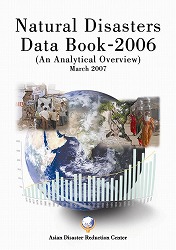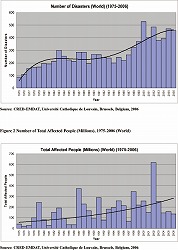Natural Disasters Data Book 2006

An Analytical Overview March 2007
foreword
 Like previous years, 2006 brought several severe natural disasters around the world. The earthquake and subsequent tsunami that struck Indonesia yielded the highest death toll, while the floods in China, the Philippines, India and the Southeast Asian countries affected the greatest number of people. Windstorms, floods, and landslides in the Philippines and China and the earthquake that hit Indonesia produced the most extensive economic damage. These disasters were further compounded by the floods and wind storms in the US and Australia. These disasters, particularly those that occurred in Asia, severely impacted the development and economic advancement of China, Indonesia, the Philippines, India, Thailand, and Viet Nam, almost paralyzing them. Consequently, these disasters affected the entire Asian region and presented severe setbacks to economic development. Droughts and epidemics also occurred in many African countries in 2006, resulting in extensive human casualties and economic damage. Even more unexpectedly, Europe experienced floods and extreme temperatures (cold wave) as it did in 2004 (heat wave), which claimed a considerable number of lives and caused extensive casualties in the region. Oceania also experienced severe storms, floods and volcanic activity that affected many people and caused significant economic damage.
Like previous years, 2006 brought several severe natural disasters around the world. The earthquake and subsequent tsunami that struck Indonesia yielded the highest death toll, while the floods in China, the Philippines, India and the Southeast Asian countries affected the greatest number of people. Windstorms, floods, and landslides in the Philippines and China and the earthquake that hit Indonesia produced the most extensive economic damage. These disasters were further compounded by the floods and wind storms in the US and Australia. These disasters, particularly those that occurred in Asia, severely impacted the development and economic advancement of China, Indonesia, the Philippines, India, Thailand, and Viet Nam, almost paralyzing them. Consequently, these disasters affected the entire Asian region and presented severe setbacks to economic development. Droughts and epidemics also occurred in many African countries in 2006, resulting in extensive human casualties and economic damage. Even more unexpectedly, Europe experienced floods and extreme temperatures (cold wave) as it did in 2004 (heat wave), which claimed a considerable number of lives and caused extensive casualties in the region. Oceania also experienced severe storms, floods and volcanic activity that affected many people and caused significant economic damage.
The prevalence and magnitude of these natural disasters have clearly had serious consequences for many societies, national economies, and the global environment. Natural disasters have increased noticeably in frequency and severity all over the world. The exponential increase in economic losses associated with natural hazards in the developing countries poses a major obstacle to development. Thus, the devastation caused by natural disasters and the economic uncertainties they create have had an adverse effect on the ability of developing countries to compete in the global economy. The statistics for the last 30 years clearly show that Asia is the most disaster-afflicted region in the world, accounting for about 90% of all those affected by disasters, and more than 50% of the total fatalities and economic losses. It is therefore imperative that we analyze past disasters and look at annual trends from the perspective of development mechanisms.
We have compiled this publication to analyze the natural disaster trends in the year 2006 for the purpose of accelerating and strengthening global and regional socio-economic frameworks for addressing the consequences of natural disasters and designing effective disaster reduction mechanisms. We hope this publication will be of use not only to policy planners, researchers, and scholars, but also to grass-roots promoters of development initiatives. We sincerely hope that this data book will further our efforts to transform the total disaster risk management approach into an instrument for global sustainable development.
March 2007
Contents
Chapter 1
1-1 Trends in Natural Disaster Damage and Characteristics
1-2 Regional Vulnerability: Disaster-Prone Asia
1-3 Vulnerabilities of Countries with Small Economies and Populations
Chapter 2
Natural Disasters and Sustainable Development
2-1 Human Development and Natural Disasters
2-2 Gender Issues and Natural Disaster Impacts
2-3 The Economics and Natural Disasters
2-4 Disaster Classification and the Impact of Development Characteristics
Chapter 3
Regional Characteristics of Natural Disasters
3-1 Proportion of Natural Disasters by Region
3-2 Natural Disasters Around the World
3-2-1 Characteristics of Disasters in Africa
3-2-2 Characteristics of Disasters in the Americas
3-2-3 Characteristics of Disasters in Asia
3-2-4 Characteristics of Disasters in Europe
3-2-5 Characteristics of Disasters in Oceania
Chapter 4
Overview of Natural Disasters in Asian and ADRC Member Countries
4-1 Types of Disasters and Their Effects on Asian and ADRC Member Countries
4-2 Disaster Profiles of the Asian and ADRC Member Countries
4-3 Conclusions

